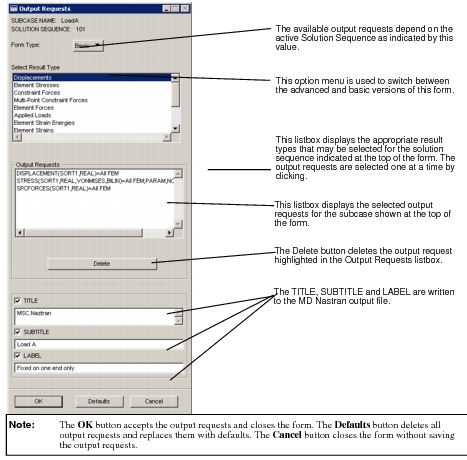
Note: | Many of the output requests that can be defined on the Output Request forms currently apply only to the printed values in the MD Nastran output file; these result quantities cannot be imported and postprocessed in Patran. For guidance on specific quantities, review Supported OUTPUT2 Result and Model Quantities, 480. |

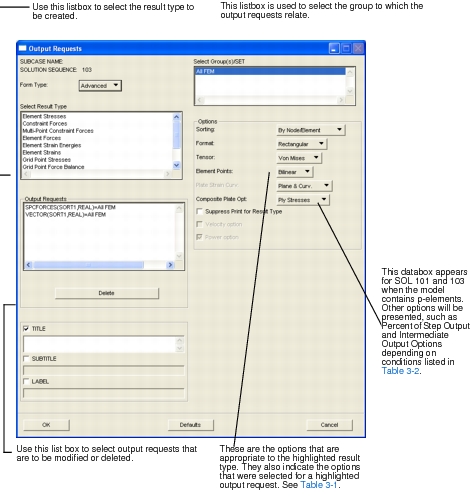
Output Request | Case Control Command or Bulk Data Entry | Description |
Acoustic Intensity | INTENSITY | Requests acoustic intensity for external acoustics analysis (frequency response). |
Acoustic Power | ACPOWER | Requests acoustic power radiated from surface for external acoustics analysis (frequency response). |
Acoustic Field Point Mesh | ACFPMRESULT | Requests acoustic field point mesh results for external acoustics analysis (frequency response). You are given a list of all acoustic field point meshes defined and groups with nodes. Each one selected is translated into its own BEGIN AFPM section in the bulk data. |
Acoustic Velocities | VELOCITY | Requests nodal velocities. This is for acoustic velocities at the node points of Field Point Mesh. |
Displacements | DISPLACEMENT | Requests nodal displacements. |
Eigenvectors | VECTOR | Requests nodal eigenvectors. |
Element Stresses | STRESS | Requests elemental stresses. |
Constraint Forces | SPCFORCES | Requests forces of single- point constraints. |
MultiPoint Constraint Forces | MPCFORCES | Requests forces of multipoint constraints (for versions 68 or higher). |
Element Forces | FORCE | Requests elemental forces. |
Applied Loads | OLOAD | Requests equivalent nodal applied loads. |
Nonlinear Applied Loads | NLLOAD | Requests equivalent nonlinear applied loads. Sorting and format options are not allowed with this request. |
Element Strain Energies | ESE | Requests elemental strain energies and energy densities. No options are allowed with this output request. |
Element Strains | STRAIN | Requests elemental strains. |
Grid Point Stresses | GPSTRESS | Requests stresses at grid points. |
Velocities | VELOCITY | Requests nodal velocities. |
Accelerations | ACCELERATION | Requests nodal accelerations. |
Grid Point Force Balance | GPFORCE | Requests grid point force balance at nodes. Sorting and format options are not allowed with this request. |
Grid Point Stress Discontinuities | GPSDCON | Requests mesh stress discontinuities based on grid point stresses. |
Element Stress Discontinuity | ELSDCON | Requests mesh stress discontinuities based on element stresses. |
Nonlinear Stress | NLSTRESS | Requests the form and type of nonlinear element stress output. |
Contact Results | BOUTPUT | Requests contact regions for output. |
Options | Label | Case Control or Bulk Data Options | Groups | Multiple Select Allowed | Descriptions |
Sorting | By Node/ Element | SORT1 | Elements | No | Output is presented as tabular listing of nodes/elements for each load, frequency, eigenvalue, or time. |
By Frequency/ Time | SORT2 | Elements | No | Output is presented as tabular listing of frequency or time for each node or element. | |
Format | Rectangular | REAL | Elements | No | Requests real and imaginary format for complex output. |
Polar | PHASE | Elements | No | Requests magnitude and phase format for complex output. | |
Tensor | Von Mises | VONMISES | Elements | No | Requests von Mises stresses or strains. |
Maximum Shear | MAXS | Elements | No | Requests Maximum shear or Octahedral stresses or strains. | |
Element Points | Cubic | CUBIC | Elements | No | Requests QUAD4 stresses or strains at the corner grid points as well as the center using the strain gage approach with cubic bending correction. |
Corner | CORNER | Elements | No | Requests QUAD4 stresses or strains at the corner grid points as well as the center. | |
Center | CENTER | Elements | No | Requests QUAD4 stresses or strains at the center only. | |
Strain Gage | SGAGE | Elements | No | Requests QUAD4 stresses or strains at the corner grid points as well as the center using the strain gage approach. | |
Bilinear | BILIN | Elements | No | Requests QUAD4 stresses or strains at the corner grid points as well as the center using bilinear extrapolation. | |
Composite Plate Options | Element Stresses | NOCOMPS= -1, LSTRN = 0 in Bulk Data | Elements: Surfaces | No | Composite element ply stresses and failure indices are suppressed. Element stresses for the equivalent homogeneous element are output. |
Ply Stresses | NOCOMPS=1,LSTRN = 0 in Bulk Data | Elements: Surfaces | No | Composite element ply stresses and failure indices are output. Model should contain PCOMP entry defining composites. | |
Composite Plate Options | Ply Strains | NOCOMPS=1,LSTRN = 1 in Bulk Data | Elements: Surfaces | No | Composite element ply strains and failure indices are output. Model should contain PCOMP entry defining composites. |
Ply Element Stresses | NOCOMPS=0,LSTRN=0 in Bulk Data | Elements: Surfaces | No | Composite element ply stresses and failure indices as well as Element stresses for the equivalent homogeneous element are output. Model should contain PCOMP entry defining composites. | |
Element and Ply Strains | NOCOMPS=0,LSTRN=1 in Bulk Data | Elements: Surfaces | No | Composite element ply strains and failure indices as well as Element stresses for the equivalent homogeneous element are output. Model should contain PCOMP entry defining composites. | |
Plate Strain Options | Plane Curv. | STRCUR | Elements: Surfaces | No | This option is available for Element Strains output requests only. Strains and curvatures are output at the reference plane for plate elements. |
Fiber | FIBER | Elements: Surfaces | No | This option is available for Element Strains output requests only. Strains at locations Z1 and Z2 (specified under element properties) are output at the reference plane for plate elements. | |
Sorting | By Node /Element | SORT1 | Nodes | No | Output is presented as tabular listing of nodes/elements for each load, frequency, eigenvalue, or time. |
By Frequency/ Time | SORT2 | Nodes | No | Output is presented as tabular listing of frequency or time for each node or element. | |
Format | Rectangular | REAL | Nodes | No | Requests real and imaginary format for complex output. |
Polar | PHASE | Nodes | No | Requests magnitude and phase format for complex output. | |
Output Coordinate | Coord | COORD CID | Elements: Surfaces, Volumes | Yes | Selects the output coordinate frame for grid point stress output. Coord 0 is the basic coordinate frame. |
Volume Output | Both | Blank | Elements:Volumes | Yes | Requests direct stress, principal stresses, direction cosines, mean pressure stress and von Mises equivalent stresses to be output. |
Principal | PRINCIPAL | Elements:Volumes | Yes | Requests principal stresses, direction cosines, mean pressure stress and von Mises equivalent stresses to be output. | |
Direct | DIRECT | Elements:Volumes | Yes | Requests direct stress, mean pressure stress and von Mises equivalent stresses to be output. | |
Fiber | All | FIBER, ALL | Elements: Surfaces | Yes | Specifies that grid point stresses will be output at all fibre locations, that is at Z1, Z2 and the reference plane. Z1 and Z2 distances are specified as element properties (default Z1=-thickness/2, Z2= +thickness/2). |
Fiber | Mid | FIBER, MID | Elements: Surfaces | Yes | Specifies that grid point stresses will be output at the reference plane. |
Z1 | FIBER, Z1 | Elements: Surfaces | Yes | Specifies that grid point stresses will be output at distance Z1 from the reference plane (default Z1=-thickness/2). | |
Z2 | FIBER, Z2 | Elements: Surfaces | Yes | Specifies that grid point stresses will be output at distance Z2 from the reference plane (default Z2=+thickness/2). | |
Normal | X1 | NORMAL X1 | Elements: Surfaces, | Yes | Specifies the x-axis of the output coordinate frame to be the reference direction for the positive fiber and shear stress output. |
X2 | NORMAL X2 | Elements: Surfaces | Yes | Specifies the y-axis of the output coordinate frame to be the reference direction for the positive fiber and shear stress output. | |
X3 | NORMAL X3 | Elements: Surfaces | Yes | Specifies the z-axis of the output coordinate frame to be the reference direction for the positive fiber and shear stress output. | |
Method | Topological | TOPOLOGI-CAL | Elements: Surfaces | Yes | Specifies the topological method for calculating average grid point stresses. This is the default. |
Geometric | GEOMETRIC | Elements: Surfaces | Yes | Specifies the geometric interpolation method for calculating average grid point stresses. This method should be used when there are large differences in slope between adjacent elements. | |
X-axis of Basic Coord | X1 | AXIS, X1 | Elements: Surfaces | Yes | Specifies that the x-axis of the output coordinate frame should be used as the x-output axis and the local x-axis when geometric interpolation method is used. |
X-axis of Basic Coord | X2 | AXIS, X2 | Elements: Surfaces | Yes | Specifies that the y-axis of the output coordinate frame should be used as the x-output axis and the local x-axis when geometric interpolation method is used. |
X3 | AXIS, X3 | Elements: Surfaces | Yes | Specifies that the z-axis of the output coordinate frame should be used as the x-output axis and the local x-axis when geometric interpolation method is used. | |
Branch | Break | BREAK | Elements: Surfaces | Yes | Treats multiple element intersections as stress discontinuities in the geometric interpolation method. |
No Break | NOBREAK | Elements: Surfaces | Yes | Does not treat multiple element intersections as stress discontinuities in the geometric interpolation method. | |
Tolerance | 0.0 | TOL=0.0 | Elements: Surfaces | Yes | Defines the tolerance to be used for interelement slope differences. Slopes beyond this tolerance will signify discontinuous stresses. |
Percent of Step Output | 100 | NOi Field of TSTEP and TSTEPNL entry | All | Once per subcase | An integer ‘n’ that specifies the percentage of intermediate outputs to be presented for transient and nonlinear transient analyses. |
Adaptive Cycle Output Interval | 0 | BY = n on OUTPUT Bulk Data entry | p-elements | Once per subcase | An integer ‘n’ that requests intermediate outputs for each nth adaptive cycle. For n=0, only the last adaptive cycle results are output. This is available for SOLs 101 and 103 for versions 68 and higher. |
Intermediate Output Options | Yes | INTOUT field of NLPARM Bulk Data entry | All | Once per subcase | Intermediate outputs are requested for every computed load increment. Applicable for nonlinear static solution type only. |
No | INTOUT field of NLPARM Bulk Data entry | All | Once per subcase | Intermediate outputs are requested for the last load of the subcase. Applicable for nonlinear static solution type only. | |
All | INTOUT field of NLPARM Bulk Data entry | All | Once per subcase | Intermediate outputs are requested for every computed and user-specified load increment. Applicable for nonlinear static solution type only. | |
Suppress Print for Result Type | N/A | Specifies PLOT option instead of PRINT on the Case Control Output request entry. | All | Yes | Print to the .f06 file is suppressed for the result type when this is selected. |
Output Device Options | Print | Specifies PRINT on a Case Control request entry, e.g. DISPL. | All | Yes | The printer will be the output medium for the .f06 file. |
Punch | Specifies PUNCH on a Case Control request entry, e.g. DISPL. | All | Yes | The punch file will be the output medium. | |
Both | Specifies both PRINT and PUNCH. | All | Yes | The printer and punch file will be the output medium. |
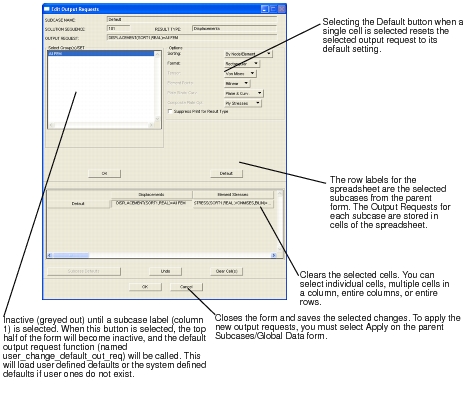
mscn_user_add_out_req | (or_num, or_value) |
Description: | ||||
This function adds either a specified version or a default version of an Output Request type to the list of default Output Requests. | ||||
Input: | ||||
INTEGER | or_num | The OR number of the output request type to add (See Table 3‑3). | ||
STRING | or_value | The value of the selected output request type. Blank implies the default value. | ||
mscn_user_del_out_req | (or_num) |
Description: | ||||
This function deletes the specified Output Request type from the list of default Output Requests. | ||||
Input: | ||||
INTEGER | or_num | The OR number of the Output Request type to delete (See Table 3‑3). | ||
FUNTION user_change_default_out_req(sol_seq)
INTEGER sol_seq
IF (sol_seq == 101 || sol_seq == 106) THEN
/* This will add this version of the Output Request type to the list of default */
/* Output Requests for solution 101 and 106. */
mscn_user_add_out_req (4,”MPCFORCES(SORT2,REAL)=ALL FEM”)
/* This will add the default version of these Output Request types from the list */
/* of default Output Requests for solution 101 and 106. */
mscn_user_add_out_req (10,“ ”)
mscn_user_add_out_req (6,“ ”)
/* This will delete these Output Request types from the list of default */
/* Output Requests for solution 101 and 106. */
mscn_user_del_out_req (1)
mscn_user_del_out_req (2)
mscn_user_del_out_req (3)
END IF
END FUNCTION
Result ID Number (Solution Sequence) | OR Number | |||||||||||||||||||||||
1 | 2 | 3 | 4 | 5 | 6 | 7 | 8 | 9 | 10 | 11 | 12 | 13 | 14 | 15 | 16 | 17 | 18 | 19 | 20 | 21 | 22 | 23 | 24 | |
101 | x | x | x | o | o | o | o | o | o | o | o | o | o | o | o | x | ||||||||
103 | o | o | x | o | o | o | o | o | o | o | x | |||||||||||||
105 | x | o | x | o | o | o | o | o | o | o | o | x | ||||||||||||
106 | x | x | x | o | o | o | o | o | x | |||||||||||||||
107 | o | o | x | o | o | o | x | |||||||||||||||||
108 | x | o | x | o | o | o | o | o | o | o | ||||||||||||||
109 | x | o | x | o | o | o | o | o | o | o | o | o | ||||||||||||
110 | o | o | x | o | o | o | x | |||||||||||||||||
111 | x | o | x | o | o | o | o | o | o | o | ||||||||||||||
112 | x | o | x | o | o | o | o | o | o | o | o | o | ||||||||||||
114 | x | x | x | o | o | o | o | o | o | o | x | o | o | |||||||||||
115 | o | o | x | o | o | o | o | o | o | o | ||||||||||||||
129 | x | o | x | o | o | o | o | o | o | o | ||||||||||||||
153 | o | o | o | o | o | o | x | x | o | o | ||||||||||||||
159 | o | o | o | o | o | o | x | x | o | o | o | o | ||||||||||||
400 | x | x | ||||||||||||||||||||||
600 | x | |||||||||||||||||||||||
700 | x | o | x | o | o | o | o | o | o | o | x | |||||||||||||
OR # | Default Value |
1 | DISPLACEMENT(SORT1,REAL)=All FEM |
2 | STRESS(SORT1,REAL,VONMISES,BILIN)=All FEM;PARAM,NOCOMPS,-1 |
3 | SPCFORCES(SORT1,REAL)=All FEM |
4 | MPCFORCES(SORT1,REAL)=All FEM |
5 | FORCE(SORT1,REAL,BILIN)=All FEM |
6 | OLOAD(SORT1,REAL)=All FEM |
7 | NLLOAD=All FEM |
8 | ESE=All FEM |
9 | STRAIN(SORT1,REAL,VONMISES,STRCUR,BILIN)=All FEM |
10 | GPSTRESS=All FEM; VOLUME # SET,PRINCIPAL,SYSTEM Coord 0; SURFACE # SET #,FIBRE ALL,SYSTEM Coord 0, AXIS X1,NORMAL R, TOPOLOGICAL,BRANCH BREAK |
11 | VELOCITY(SORT1,REAL)=All FEM |
12 | ACCELERATION(SORT1,REAL)=All FEM |
13 | GPFORCE=All FEM |
14 | GPSDCON=All FEM; VOLUME # SET #,PRINCIPAL,SYSTEM Coord 0; SURFACE # SET #,FIBRE ALL,SYSTEM Coord 0, AXIS X1,NORMAL R, TOPOLOGICAL 0.,BRANCH BREAK |
15 | ELSDCON=All FEM; VOLUME # SET #,PRINCIPAL,SYSTEM Coord 0; SURFACE # SET #,FIBRE ALL,SYSTEM Coord 0, AXIS X1,NORMAL R, TOPOLOGICAL 0.,BRANCH BREAK |
16 | VECTOR(SORT1,REAL)=All FEM |
17 | THERMAL=(SORT1,PRINT)=All FEM |
18 | FLUX(SORT1,PRINT)=All FEM |
19 | OLOAD(SORT1,PRINT)=All FEM |
20 | SPCFORCES(SORT1,PRINT)=All FEM |
21 | ENTHALPY(SORT1,PRINT)=All FEM |
22 | HDOT(SORT1,PRINT)=All FEM |
23 | NLSTRESS |
24 | BCCONTACT |
Note: | In SOL 109, 112 & 159 will have SORT2 as the default in some versions of Patran. |
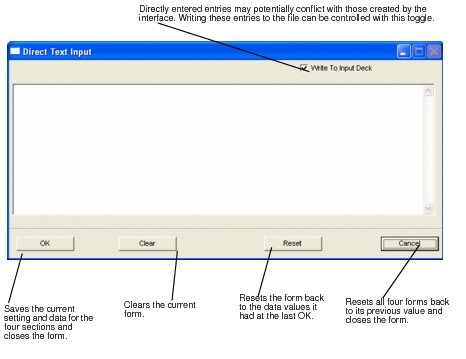
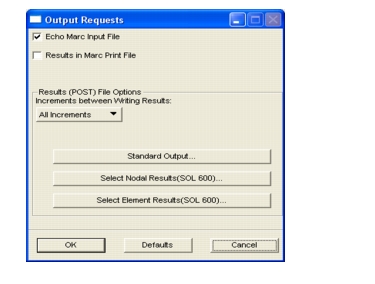
Echo Marc Input File | Produces an echo of the input file. |
Results in Marc Print File | Writes results to a print file. |
Results (POST) File Options | |
• Increments between Writing Results | Defines the number of increments between writing results to the MD Nastran results file after the first increment of the analysis. The default is one (1) for every increment. Note: You can select a fixed number of increments of output on the subcase parameters-load increments parameters form. |
• Select Nodal Results... | Brings up a subform for selecting nodal results |
• Select Element Results... | Brings up a subform for selecting elemental results. |
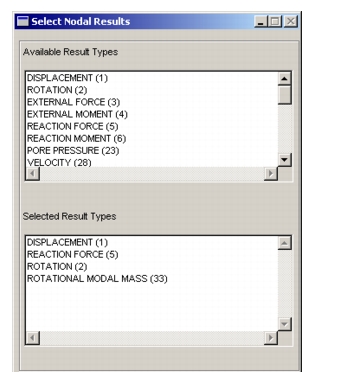
Available Result Types | Lists all of the available result types for the analysis. The numbers in parentheses are the MSC.Marc POST code numbers, that will be specified on the MARCOUT entry |
Selected Result Types | Shows the set of result types that have been selected to be returned in the analysis. |
Nodal Result | Postcode | Default(?) |
DISPLACEMENT | 1 | YES |
ROTATION | 2 | no |
EXTERNAL FORCE | 3 | no |
EXTERNAL MOMENT | 4 | no |
REACTION FORCE | 5 | YES |
REACTION MOMENT | 6 | no |
PORE PRESSURE | 23 | no |
VELOCITY | 28 | no |
ROTATIONAL VELOCITY | 29 | no |
ACCELERATION | 30 | no |
ROTATIONAL ACCELERATION | 31 | no |
MODAL MASS | 32 | no |
ROTATION MODAL MASS | 33 | no |
CONTACT NORMAL STRESS | 34 | no |
CONTACT NORMAL FORCE | 35 | no |
FRICTION STRESS | 36 | no |
FRICTION FORCE | 37 | no |
CONTACT STATUS | 38 | no |
CONTACT TOUCHED BODY | 39 | no |
HERRMANN VARIABLE | 40 | no |
POST CODE, No. -11 | -11 thru -16 | no |
POST CODE, No. -22 | -21 thru -23 | no |
POST CODE, No. -31 | -31 | no |
POST CODE, No. -41 | -41 | no |
POST CODE, No. -51 | -51 | no |
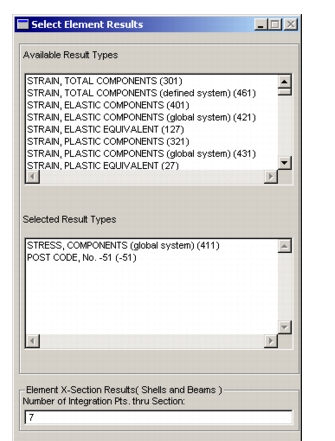
Available Result Types | Lists all of the available result types for the analysis. The numbers in parentheses are the MSC.Marc POST code numbers. |
Selected Result Types | Shows the set of result types that have been selected to be returned in the analysis. |
Element X-section Results | Defines the number of layer points to use through the cross section of homogeneous shells, plates and beams. This number must be odd if not a composite. |
Elemental Result | Postcode | Solutions | Default(?) |
STRAIN, TOTAL COMPONENTS | 301 | nonlinear only | YES |
STRAIN, TOTAL COMPONENTS (defined system) | 461 | nonlinear only | no |
STRAIN, ELASTIC COMPONENTS | 401 | any | no |
STRAIN, ELASTIC COMPONENTS (global system) | 421 | any | no |
STRAIN, ELASTIC EQUIVALENT | 127 | any | no |
STRAIN, PLASTIC COMPONENTS | 321 | nonlinear only | no |
STRAIN, PLASTIC COMPONENTS (global system) | 431 | nonlinear only | no |
STRAIN, PLASTIC EQUIVALENT | 27 | nonlinear only | no |
STRAIN, PLASTIC EQUIVALENT (from rate) | 7 | nonlinear only | no |
STRAIN, CRACKING COMPONENTS | 381 | nonlinear only | no |
STRAIN, CREEP COMPONENTS | 331 | creep only | no |
STRAIN, CREEP COMPONENTS (global system) | 441 | creep only | YES |
STRAIN, CREEP EQUIVALENT | 37 | creep only | no |
STRAIN, CREEP EQUIVALENT (from rate) | 8 | creep only | no |
STRAIN, THERMAL | 371 | any | no |
STRAIN, THICKNESS | 49 | any | no |
STRAIN, VELOCITY | 451 | nonlinear only | no |
STRESS, COMPONENTS | 311 | any | no |
STRESS, COMPONENTS (defined system) | 391 | an | no |
STRESS, COMPONENTS (global system) | 411 | any | YES |
STRESS, EQUIVALENT YIELD | 59 | nonlinear only | no |
STRESS, EQUIVALENT MISES | 17 | any | no |
STRESS, MEAN NORMAL | 18 | any | no |
STRESS, INTERLAMINAR SHEAR No. 1 | 108 | any | no |
STRESS, INTERLAMINAR SHEAR No. 2 | 109 | any | no |
STRESS, INTERLAMINAR COMPONENTS | 501,511 | any | no |
STRESS, CAUCHY COMPONENTS | 341 | nonlinear only | no |
STRESS, CAUCHY EQUIVALENT | 47 | nonlinear only | no |
STRESS, HARMONIC COMPONENTS | 351 (real) 361(imag) | harmonic only | no |
STRESS, REBAR UNDEFORMED | 471 | any | no |
STRESS, REBAR DEFORMED | 481 | any | no |
FORCES, ELEMENT | 264-269 | any | no |
BIMOMENT | 270 | any | no |
STRAIN RATE, PLASTIC | 28 | nonlinear only | no |
STRAIN RATE, EQUIVALENT VISCOPLASTIC | 175 | any | no |
STATE VARIABLE, SECOND | 29 | any | no |
STATE VARIABLE, THIRD | 39 | any | no |
TEMPERATURE, ELEMENT TOTAL | 9 | any | no |
TEMPERATURE, ELEMENT INCREMENTAL | 10 | any | no |
STRAIN ENERGY DENSITY, TOTAL | 48 | nonlinear only | no |
STRAIN ENERGY DENSITY, ELASTIC | 58 | any | no |
STRAIN ENERGY DENSITY, PLASTIC | 68 | nonlinear only | no |
THICKNESS, ELEMENT | 20 | any | no |
VOLUME, ELEMENT | 78 | any | no |
VOLUME, VOID FRACTION | 177 | any | no |
GRAIN SIZE | 79 | any | no |
FAILURE, INDEX No. 1-7 | 91-103 | any | no |
DENSITY, RELATIVE | 179 | any | no |
POST CODE, No. 19 | 19 | any | no |
POST CODE, No. 38 | 38 | any | no |
POST CODE, No. -11 | -11 thru -16 | any | no |
POST CODE, No. -21 | -21 thru -23 | any | no |
POST CODE, No. -31 | -31 | any | no |
POST CODE, No. -41 | -41 | any | no |
POST CODE, No. -51 | -51 | any | no |
^^^
^^^ ***************************************
^^^
^^^ SUMMED MODAL RESPONSES IN X-DIRECTION
^^^
^^^ ***************************************
^^^
^^^
^^^ **************************************************
^^^
^^^ INDIVIDUAL SCALED MODAL RESPONSES IN Y-DIRECTION
^^^
^^^ **************************************************
^^^